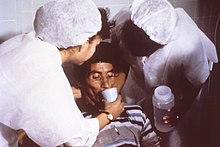第七次霍亂大流行

第七次霍亂大流行(英文:Seventh cholera pandemic),是指於1961年持續至今的霍亂大流行,是歷史上第七次霍亂的大規模爆發[1][2][3][4][5]。此次大流行起始於印度尼西亞,並傳播到全球,其致病菌是一種名叫「埃爾托」的特殊霍亂弧菌,與此前霍亂大流行的致病菌有所不同[1][4]。
截止2016年,此次疫情每年造成約300萬-500萬人受到感染,而非洲是此次疫情最嚴重的大洲[3][4]。2008年-2012年,全球每年報告140萬-400萬霍亂病例以及2.1萬-14.3萬死亡人口[3][6]。此前,1961年-1989年間,全球各個大洲共117個國家向世界衛生組織報告了霍亂病例,總計1,713,057例[7]。
各地疫情
[編輯]1961年,第七次霍亂大流行起源於印度尼西亞的望加錫地區,並與1963年傳播到南亞[3][4]。截止1966年,亞洲大部分地區都出現了疫情[5]。
1970-2011年間,數個歐洲國家報告了霍亂疫情,感染人數為幾人至2000多人不等[8]。1965-1989年間,蘇聯共報告了10,723例霍亂病例(包括病原攜帶者)[7]。
1971年,疫情蔓延至非洲[2][6]。1994年盧安達種族滅絕事件中,霍亂在一個月內至少在剛果民主共和國戈馬的難民營中造成48,000人感染、23,800人死亡[1][2]。
1991年,霍亂傳播至一個多世紀無霍亂的拉丁美洲,同年在美洲的16個國家造成近40萬報告病例和4000多人死亡,其中秘魯的霍亂爆發造成7.7億美元的損失(一說秘魯有上萬人死亡[2])[1]。
致病菌
[編輯]此次大流行的致病菌「埃爾托」與傳統的霍亂弧菌不同,它於1905年被德國醫生Felix Gotschlich成功分離,並以埃及一個名叫「El Tor」的隔離站命名[4][9]。1937年-1958年,埃爾托曾在印度尼西亞的南蘇拉威西省造成了四次死亡率很高的流行[9]。
1992年,在孟加拉國出現了一種新的血清組,是埃爾托生物型的基因衍生物、被定名為霍亂弧菌「O139 Bengal」菌株,已在至少11個國家中發現,並造成廣泛流行[1][2][5]。
參見
[編輯]參考資料
[編輯]- ^ 1.0 1.1 1.2 1.3 1.4 全球性流行和霍乱的影响. 世界衛生組織. [2021-01-03]. (原始內容存檔於2021-04-16) (中文).
- ^ 2.0 2.1 2.2 2.3 2.4 Cholera's seven pandemics. 加拿大廣播公司 (CBC). 2008-05-09 [2020-12-29]. (原始內容存檔於2018-03-30) (英語).
- ^ 3.0 3.1 3.2 3.3 Weill, François-Xavier; Domman, Daryl; Njamkepo, Elisabeth; Tarr, Cheryl; Rauzier, Jean; Fawal, Nizar; Keddy, Karen H.; Salje, Henrik; Moore, Sandra. Genomic history of the seventh pandemic of cholera in Africa. Science. 2017-11-10, 358 (6364): 785–789 [2021-01-03]. ISSN 0036-8075. PMID 29123067. doi:10.1126/science.aad5901. (原始內容存檔於2021-04-22) (英語).
- ^ 4.0 4.1 4.2 4.3 4.4 Hu, Dalong; Liu, Bin; Feng, Lu; Ding, Peng; Guo, Xi; Wang, Min; Cao, Boyang; Reeves, Peter R.; Wang, Lei. Origins of the current seventh cholera pandemic. Proceedings of the National Academy of Sciences of the United States of America. 11 29, 2016, 113 (48): E7730–E7739 [2021-01-03]. ISSN 1091-6490. PMC 5137724
 . PMID 27849586. doi:10.1073/pnas.1608732113. (原始內容存檔於2021-04-16).
. PMID 27849586. doi:10.1073/pnas.1608732113. (原始內容存檔於2021-04-16).
- ^ 5.0 5.1 5.2 Lam, Connie; Octavia, Sophie; Reeves, Peter; Wang, Lei; Lan, Ruiting. Evolution of Seventh Cholera Pandemic and Origin of 1991 Epidemic, Latin America - Volume 16, Number 7—July 2010 - Emerging Infectious Diseases journal - CDC. [2021-01-03]. doi:10.3201/eid1607.100131. (原始內容存檔於2018-09-23) (美國英語).
- ^ 6.0 6.1 霍乱. 世界衛生組織. [2021-01-03]. (原始內容存檔於2020-10-19) (中文).
- ^ 7.0 7.1 Narkevich, M. I.; Onischenko, G. G.; Lomov, J. M.; Moskvitina, E. A.; Podosinnikova, L. S.; Medinsky, G. M. The seventh pandemic of cholera in the USSR, 1961-89.. Bulletin of the World Health Organization. 1993, 71 (2): 189–196 [2021-01-03]. ISSN 0042-9686. PMC 2393457
 . PMID 8490982. (原始內容存檔於2021-06-16).
. PMID 8490982. (原始內容存檔於2021-06-16).
- ^ Oprea, Mihaela; Njamkepo, Elisabeth; Cristea, Daniela; Zhukova, Anna; Clark, Clifford G.; Kravetz, Anatoly N.; Monakhova, Elena; Ciontea, Adriana S.; Cojocaru, Radu. The seventh pandemic of cholera in Europe revisited by microbial genomics. Nature Communications. 2020-10-22, 11 (1): 5347. ISSN 2041-1723. doi:10.1038/s41467-020-19185-y (英語).
- ^ 9.0 9.1 Chastel, Claude. [The centenary of the discovery of the vibrio El Tor (1905) or dubious beginnings of the seventh pandemic of cholera]. Histoire Des Sciences Medicales. 2007-01, 41 (1): 71–82. ISSN 0440-8888. PMID 17992832.
